Art by Mark A. Garlick
Our star, the sun, will die a quiet death. The sun’s of only average mass, starwise, and after burning through the last of its hydrogen fuel in about five billion years, its outer layers will drift away, and the core will eventually compact to become what’s known as a white dwarf, an Earth-size ember of the cosmos.
For a star ten times as big as the sun, death is far more dramatic. The outer layers are blasted into space in a supernova explosion that, for a couple of weeks, is one of the brightest objects in the universe. The core, meanwhile, is squeezed by gravity into a neutron star, a spinning ball bearing a dozen miles in diameter. A sugar-cube-size fragment of a neutron star would weigh a billion tons on Earth; a neutron star’s gravitational pull is so severe that if you were to drop a marshmallow on it, the impact would generate as much energy as an atom bomb.
But this is nothing compared with the death throes of a star some 20 times the mass of the sun. Detonate a Hiroshima-like bomb every millisecond for the entire life of the universe, and you would still fall short of the energy released in the final moments of a giant-star collapse. The star’s core plunges inward. Temperatures reach 100 billion degrees. The crushing force of gravity is unstoppable. Hunks of iron bigger than Mount Everest are compacted almost instantly into grains of sand. Atoms are shattered into electrons, protons, neutrons. Those minute pieces are pulped into quarks and leptons and gluons. And so on, tinier and tinier, denser and denser, until...
Until no one knows. When trying to explain such a momentous phenomenon, the two major theories governing the workings of the universe—general relativity and quantum mechanics—both go haywire, like dials on an airplane wildly rotating during a tailspin.
The star has become a black hole.
What makes a black hole the darkest chasm in the universe is the velocity needed to escape its gravitational pull. To overcome Earth’s clutches, you must accelerate to about seven miles a second. This is swift—a half dozen times faster than a bullet—but human-built rockets have been achieving escape velocity since 1959. The universal speed limit is 186,282 miles a second, the speed of light. But even that isn’t enough to defeat the pull of a black hole. Therefore whatever’s inside a black hole, even a beam of light, cannot get out. And due to some very odd effects of extreme gravity, it’s impossible to peer in. A black hole is a place exiled from the rest of the universe. The dividing line between the inside and outside of a black hole is called the event horizon. Anything crossing the horizon—a star, a planet, a person—is lost forever.
Albert Einstein, one of the most imaginative thinkers in the history of physics, never believed black holes were real. His formulas allowed for their existence, but nature, he felt, would not permit such objects. Most unnatural to him was the idea that gravity could overwhelm the supposedly mightier forces—electromagnetic, nuclear—and essentially cause the core of an enormous star to vanish from the universe, a cosmic-scale David Copperfield act.
Einstein was hardly alone. In the first half of the 20th century most physicists dismissed the idea that an object could become dense enough to asphyxiate light. To lend it any more credence than one would give the tooth fairy was to risk career suicide.
Still, scientists had wondered about the possibility as far back as the 18th century. English philosopher John Michell mentioned the idea in a report to the Royal Society of London in 1783. French mathematician Pierre-Simon Laplace predicted their existence in a book published in 1796. No one called these superdense curiosities black holes—they were referred to as frozen stars, dark stars, collapsed stars, or Schwarzschild singularities, after the German astronomer who solved many theoretical equations about them. The name “black hole” was first used in 1967, during a talk by American physicist John Wheeler at Columbia University in New York City.
And now today's blog is to present "A picture of a lifetime for a photographer" a picture of the day by NASA. Mr. Google sure contains a wealth of information. Here is a picture a day, many photographed by our national pride and joy, the Hubble Telescope. Here are the 2013 ten best you tubes of the Hubble Telescopes best photographs. A must view.
http://www.youtube.com/watch?v=VmJeE_33R5E
Astronomy Picture of the Day
Discover the cosmos! Each day a different image or photograph of our fascinating universe is featured, along with a brief explanation written by a professional astronomer. 2014 March 6
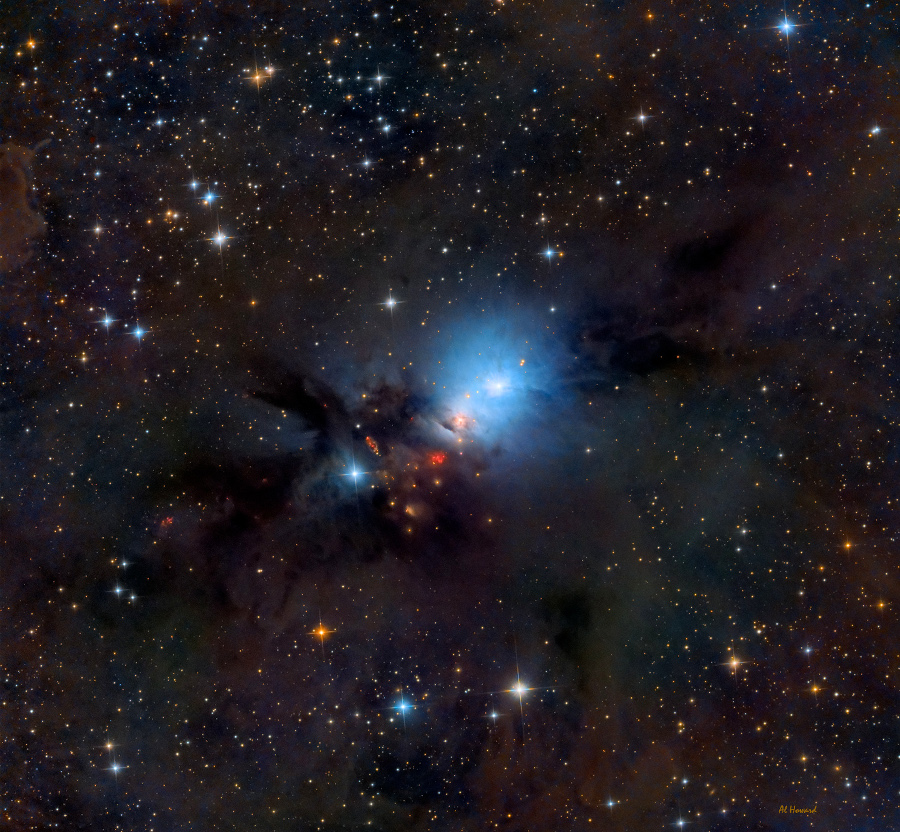 NGC 1333 Stardust
NGC 1333 Stardust
Image Credit & Copyright: Al Howard
Explanation: NGC 1333 is seen in visible light as a
reflection nebula, dominated by bluish hues characteristic of starlight reflected by dust. A mere 1,000 light-years distant toward the heroic constellation
Perseus, it lies at the edge of a large,
star-forming molecular cloud.
This striking close-up view spans about two full moons on the sky or just over 15 light-years at the estimated distance of NGC 1333. It shows details of the dusty region along with hints of contrasting red emission from
Herbig-Haro objects,
jets and shocked glowing gas emanating from recently formed stars. In fact, NGC 1333 contains hundreds of stars less than a million years old,
most still hidden from optical telescopes by the
pervasive stardust. The chaotic environment may be similar to one in which our own Sun formed over 4.5 billion years ago.
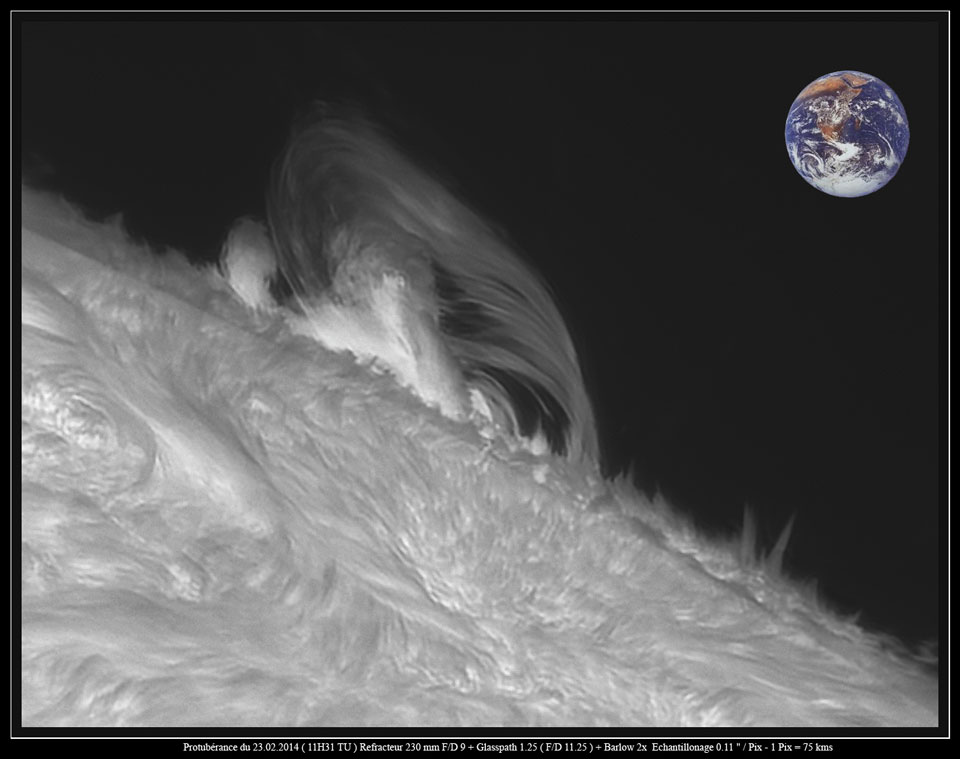
2014 March 4
Sun and Prominence
Image Credit & Copyright: jp-Brahic
Explanation: Dramatic
prominences can sometimes be seen looming just beyond the edge of the sun. Such was the case last week as a large prominence,
visible above, highlighted a highly active recent Sun. A waving
sea of hot gas is visible in the foreground chromosphere in great detail as it was imaged in one
specific color of light emitted by hydrogen. A
solar prominence is a cloud of solar gas held just above the surface by the
Sun's magnetic field. The
Earth, illustrated in the inset, is smaller than the
prominence. Although very hot, prominences typically
appear dark when viewed against the
Sun, since they are slightly cooler than the
photosphere below them. A
quiescent prominence typically lasts about a month, and may
erupt in a
Coronal Mass Ejection (CME) expelling hot gas into the
Solar System, some of which may strike the Earth and trigger
auroras.
2014 February 27
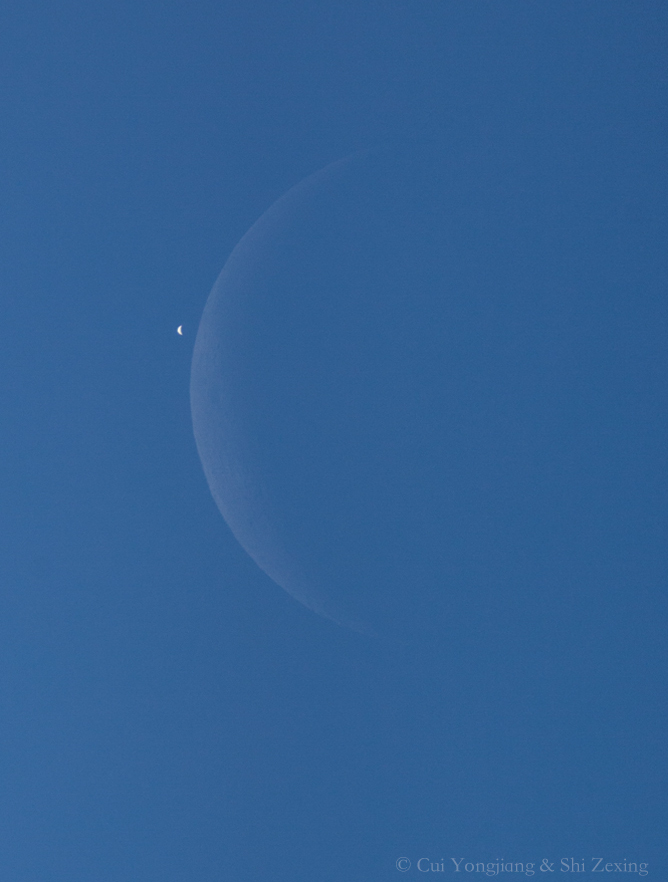 Daytime Moon Meets Morning Star
Daytime Moon Meets Morning Star
Image Credit & Copyright: Cui Yongjiang and Shi Zexing
Explanation: Venus now appears as planet Earth's brilliant
morning star standing above the eastern horizon before dawn.
For most, the silvery celestial beacon rose in a close pairing with an old crescent Moon on February 26. But
seen from locations in western Africa before sunrise, the lunar crescent actually occulted or passed in front of Venus, also in a crescent phase. Farther to the east, the occultation occurred during daylight hours. In fact, this telescopic snapshot of the
dueling crescents was captured just before the occultation began under an afternoon's crystal clear skies from
Yunnan Province, China. The unforgettable scene was easily visible to the naked eye in broad daylight.
2014 February 23
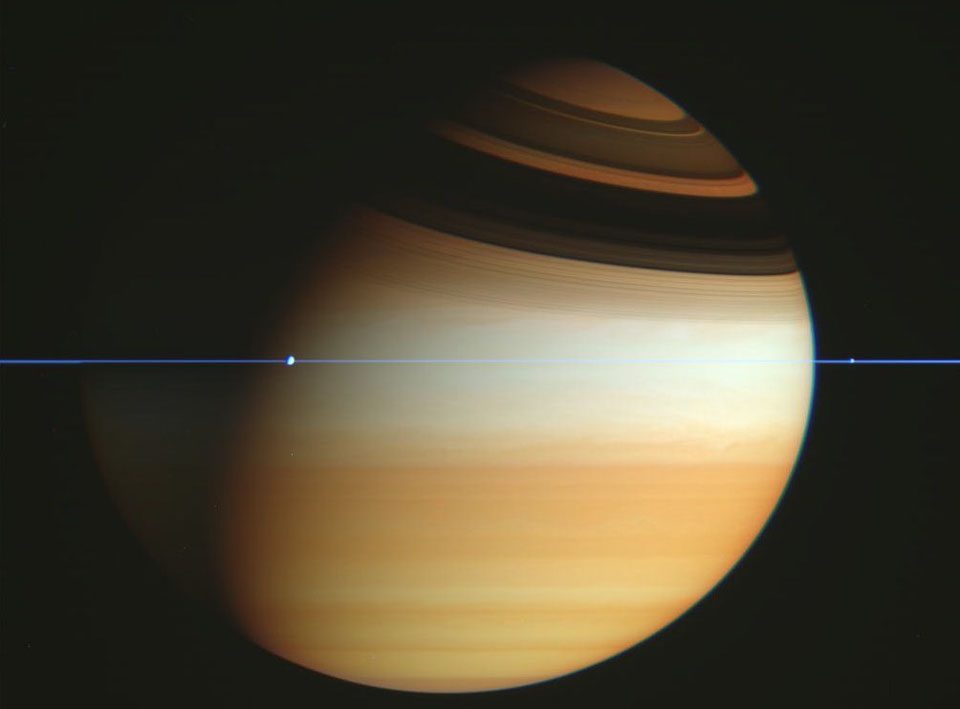 Cassini Spacecraft Crosses Saturn's Ring Plane
Cassini Spacecraft Crosses Saturn's Ring Plane
Image Credit: Cassini Imaging Team, ISS, JPL, ESA, NASA
Explanation: If this is Saturn, where are the rings? When Saturn's "appendages"
disappeared in 1612,
Galileo did not understand why. Later that century, it became understood that
Saturn's unusual protrusions were rings and that when the
Earth crosses the ring plane, the edge-on rings will
appear to disappear. This is because Saturn's rings are confined to a
plane many times thinner, in proportion, than a
razor blade. In modern times, the
robot Cassini spacecraft orbiting Saturn now also crosses
Saturn's ring plane. A series of plane crossing images from 2005 February was dug out of the vast
online Cassini raw image archive by interested Spanish amateur Fernando Garcia Navarro.
Pictured above, digitally cropped and set in representative colors, is the striking result.
Saturn's thin ring plane appears in blue, bands and clouds in
Saturn's upper atmosphere appear in gold. Details of Saturn's rings can be seen in the high
dark shadows across the top of this image, taken back in 2005. Moons appear as bumps in the rings.
2014 February 18
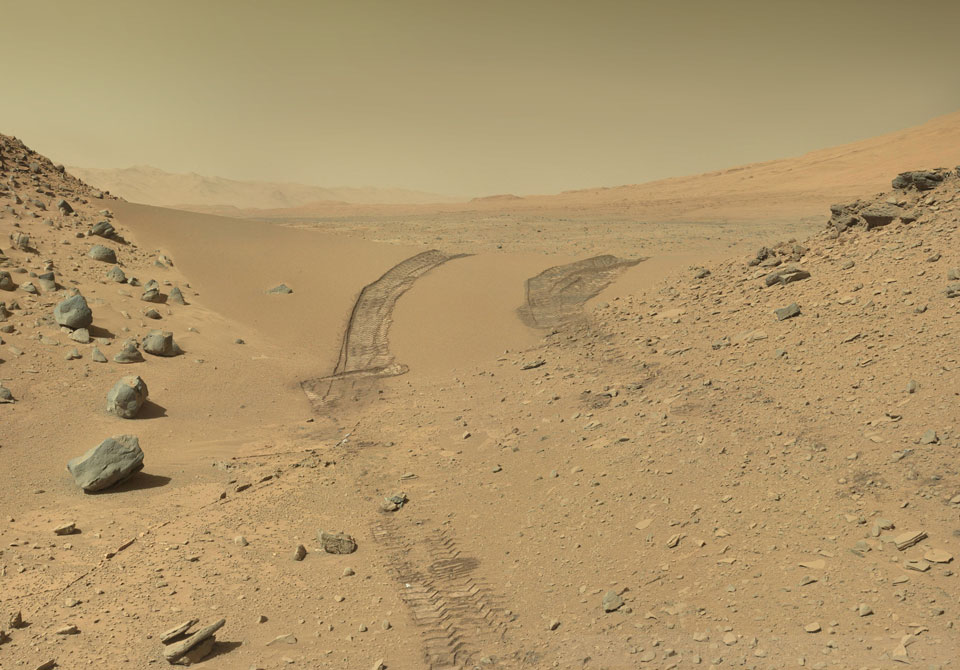 Crossing Dingo Gap on Mars
Crossing Dingo Gap on Mars
Image Credit: NASA, JPL-Caltech, MSSS; Digital processing: Damia Bouic
Explanation: An important threshold on Mars has now been crossed. Landing in mid-2012, the Curiosity rover is searching for clues of whether
life could ever have existed on the
red planet. Recent findings of Curiosity include evidence for an ancient (but now dried)
freshwater lake, and the
non-detection of the
biomarker methane in the Martian atmosphere. To continue its investigation, the car-sized rover is on an
expedition to roll up
Mt. Sharp, the central peak of the large crater in which it
landed. Life might have shown preference for
water that once ran down the Martian mountain. Two weeks ago, to avoid more dangerous and
rocky terrain, Curiosity was directed to roll across a one-meter high sand dune that blocked a
useful entrance to Mt. Sharp. Just after the short trip over
Dingo Gap was successful, the robotic rover took the
above image showing the now-traversed
sand mound covered with its
wheel tracks.
2014 February 14
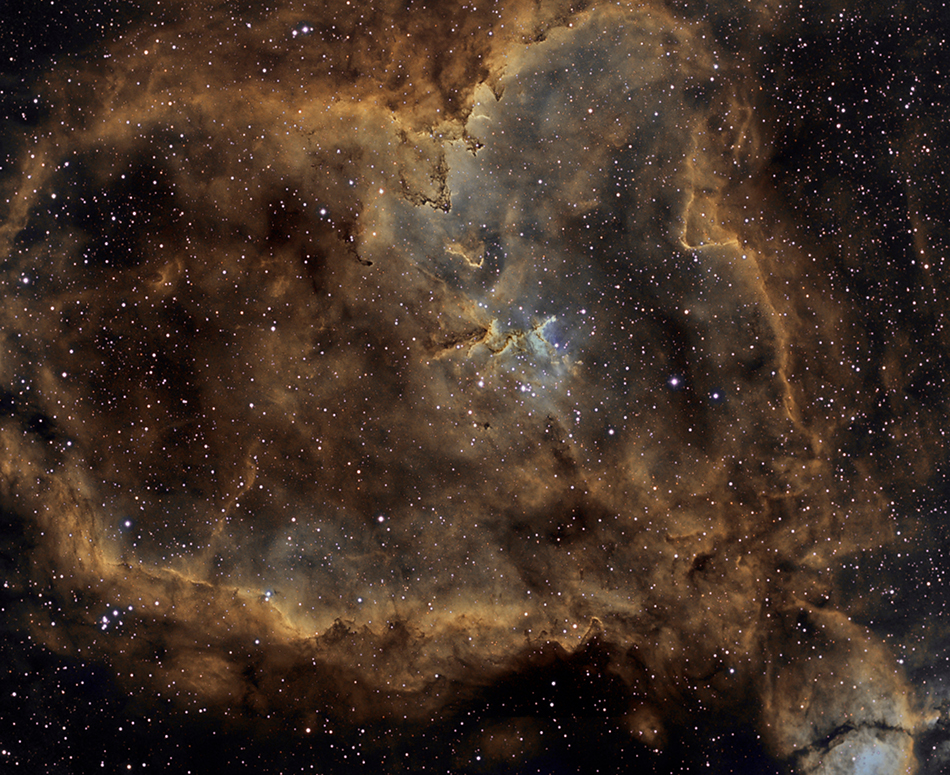 IC 1805: Light from the Heart
IC 1805: Light from the Heart
Image Credit & Copyright: César Blanco González
Explanation: Sprawling across almost 200 light-years,
emission nebula IC 1805 is a mix of glowing interstellar gas and dark dust clouds about 7,500 light-years away in the Perseus
spiral arm of our galaxy. Stars were born in this region whose nickname, the Heart Nebula, derives from its
Valentine's-Day-appropriate shape. The clouds themselves are shaped by stellar winds and radiation from massive hot stars in the nebula's newborn star cluster
Melotte 15 about 1.5 million years young. This
deep telescopic image maps the pervasive light of narrow
emission lines from atoms in the nebula to a color
palette made popular in Hubble images of star forming regions. The field of view spans about two degrees on the sky or four times the diameter of a full moon. The cosmic heart is found in the constellation of
Cassiopeia, the boastful
mythical Queen of
Aethiopia .
and my favorite.
2014 February 2
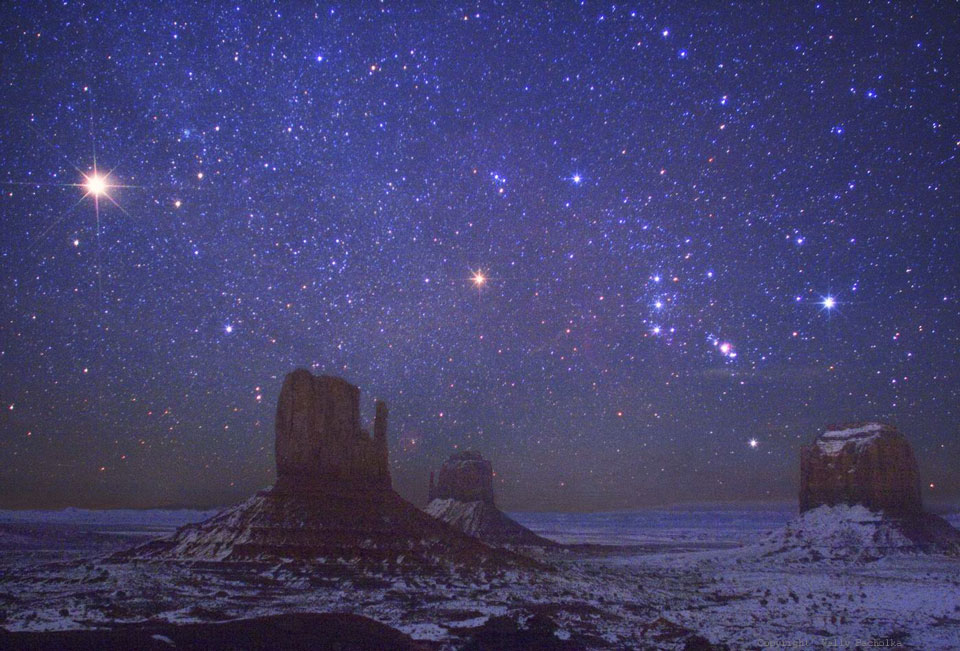 Mars and Orion over Monument Valley
Mars and Orion over Monument Valley
Image Credit & Copyright: Wally Pacholka (Astropics, TWAN)
Explanation: Welcome to
The World At Night. Sharing the night sky seen around the world, this view from
Monument Valley, USA includes a picturesque foreground of famous buttes.
Buttes are composed of hard rock left behind after water eroded away the surrounding soft rock. The two buttes on the image left are known as the
Mittens, while Merrick Butte is on the right. Recorded in 2007 December,
planet Mars is at the left of the skyscape, a glowing beacon of orange that is the brightest object in the frame. To the right of Mars lies the
constellation of Orion.
Betelgeuse is the reddish star near the center and the
Belt of Orion and the
Orion Nebula are farther right. Finally, the bright blue star
Rigel appears above Merrick Butte in this stunning view of
The World At Night




























































